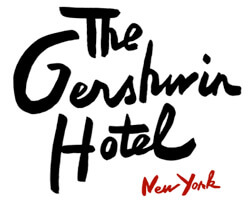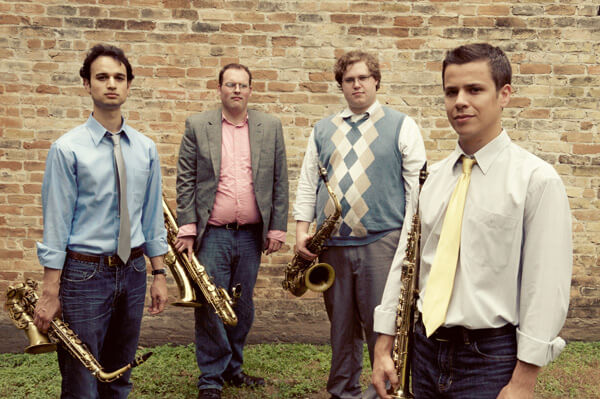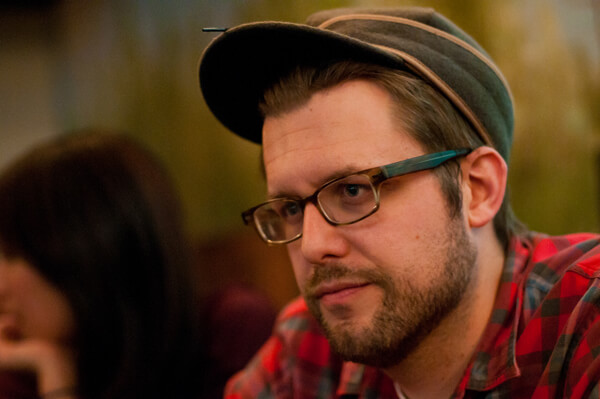 The Fast Forward Austin new music festival brought the noise to NYC with a concert February 23rd at the Contagious Sounds Series. The Bel Cuore Saxophone Quartet proved itself as an ensemble with a broad sound palette, a down to earth stage presence, and tremendous communication and spontaneity. Their selections highlighted the numerous qualities of the saxophone, from ethereal blends, lyrical wanderings, punched accents, catchy grooves, to quick dynamic contrasts, all in a way that was quite listener-friendly. With the exception of a brand new piece, they performed without music, making the spontaneity and group dynamic far more organic.
The Fast Forward Austin new music festival brought the noise to NYC with a concert February 23rd at the Contagious Sounds Series. The Bel Cuore Saxophone Quartet proved itself as an ensemble with a broad sound palette, a down to earth stage presence, and tremendous communication and spontaneity. Their selections highlighted the numerous qualities of the saxophone, from ethereal blends, lyrical wanderings, punched accents, catchy grooves, to quick dynamic contrasts, all in a way that was quite listener-friendly. With the exception of a brand new piece, they performed without music, making the spontaneity and group dynamic far more organic.

Bel Cuore Quartet - Photograph by Nathan Russell
Bel Cuore Quartet’s opener, composed by Robert Honstein, got off to a brash but sonorous beginning. I was impressed with the composer and the quartet’s willingness to go to the edge of intensity without going over the top. At times dissonant harmonies in the soprano and alto’s upper registers pierced the room, but with a beautiful quality and warmth to the sound. The bari sax held down the groove for much of the time, with the alto and tenor trading a melody with delicate finesse. At times the whole quartet locked into a punchy groove with quick and wide-ranging changes in dynamics. Honstein drew in shades of jazz, Latin, and perhaps Indian music without ever quite going to these places or losing the organic unity of the piece. The brief use of multi-phonics pitch bends, stratospheric high notes, and slap tongue were at times tasteful, though at times felt like somewhat gratuitous additions. Nevertheless it was nice to hear such a wide range of possibilities drawn out of the saxophone quartet.

Robert Honstein - Photograph by Elisa Ferrari
Jennifer Higdon’s Short Stories used different extra-musical ideas as inspiration for the sounds of its three movements. I particularly enjoyed the open, warm beginning to the second movement, inspired by a night in the desert. The third movement, titled “Splashing the Canvas,” was described as something like a Jackson Pollack painting with music instead of colors. The heavy articulations and melodic intensity lived up to their chaotic aims, and allowed the saxophone’s more abrasive qualities to shine in a way that made musical sense.
In Steven Snowden’s Speed Studies, trills became a prominent motif, and the blends created out of stacking trills in the whole quartet were an intriguing new sound. The contrast of range and timbre of the bari sax with the alto and soprano were brought to life well in this piece. A funky groove at the end performed with real kick got my head moving.
Nick Sibicky’s Life and Afterlife provided a great moment for the soprano sax to sing a melody. The warm harmonies contained and element of the ethereal (perhaps a hint of the “afterlife” in the title), and melodic lines passed from one member of the quartet to the other were handled smoothly. The second half of the piece featured some pre-recorded sounds and had the quartet playing percussion – sometimes playing the saxophone with the left hand while using a shaker or hitting a drum with the right hand. This added a new whole new sound palette, a dramatic stage effect, and a new groove to the concert.
One shortcoming of the compositions was that while the textures, grooves, and sonorities were innovative and exciting, there were not enough moments in which the instruments were given a chance to sing as individuals. I didn’t leave with much in the way of melodies stuck in my head (although the grooves and new sounds certainly made an impression on me). The brief moments of developed melodies were enticing, but left me wanting more. It’s great to see that less young composers eating the serial these days, but the influence of minimalism and pursuit of new textures has still left a void in terms of melody that I think if filled would help draw in more new listeners and (most importantly) make for better music.
One of my favorite things about this concert was the overall atmosphere. The Bel Cuore Quartet talked briefly about the pieces they were playing in a way that was down to earth (as was their whole stage presence). They looked like they were enjoying every moment performing. The Gershwin Hotel had a relaxed vibe, looked great, and the room sounded better than plenty of concert halls I’ve attended, whether the quartet was whispering or at their most intense. You could kick back and drink wine or beer from the café, but there was no wait staff bothering you and the focus was on the music (save for the faint echo of conversation outside the hall). Unlike the pretension you find at a lot of new music concerts, the Contagious Sounds Series kept it real. It felt like the audience was there for the music, not for the artsy hipster credentials, and curator Vicky Chow did us all a favor in presenting music that otherwise might not get a chance to be heard in NYC (though it certainly deserves much more performances).
To find out more about new composers and performers in Austin, Texas, visit http://www.fastforwardaustin.com/wordpress
The Contagious Sound Series holds concerts once a month at the Gershwin Hotel, visit http://www.contagioussounds.net for more info.
–
David Pearson is a saxophonist residing in NYC.






















